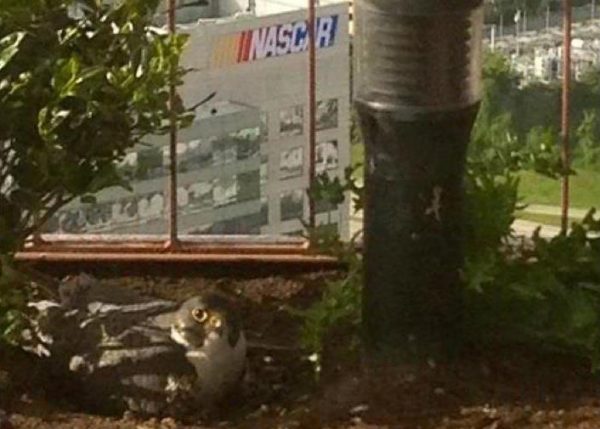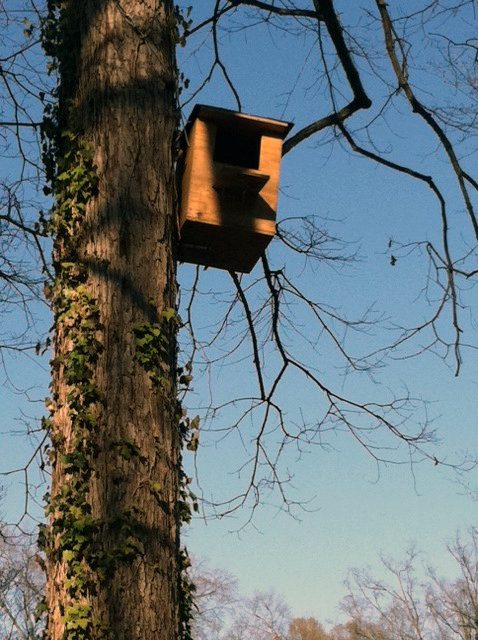Raptor City

In the Uwharries, raptors make their presence known in late winter and early spring. A lone female northern harrier has spent the winter skimming our fields of native warm season grass. I’ve come to wonder if she’s the same one who shows up every fall, who chased away another pair of harriers who tried to encroach on her territory last year. When she leaves in spring, I wonder where she spends the breeding season, and if one of her daughters might take her place some day. Higher in the sky, there has been an aerial ballet in recent weeks, the pas de deux of mating red-tailed hawks. One evening, the eastern screech owl’s hair-raising cries stopped my otherwise fearless Chihuahua in his tracks. He lowered his head and cast a furtive glance at the sky, his ears pivoting like radar devices to home in on the sound. The heart of a wolf beats in his dainty 6-pound frame – I’m sure he considers himself a top predator – but even he is cowed by a raptor’s ominous call.
I doubt a diminutive screech owl would do him any harm, but I was a little concerned about the great horned owl we often encountered at dusk when we were staying with my sister in Charlotte last month. It surveyed her yard from the limb of a neighbor’s sprawling willow oak, waiting – she hopes – for the rabbits that savage her tomatoes, cucumbers and squash. Since Jimmy Carter isn’t much larger than a bunny, I kept him by my side when we ventured out for evening walks.
 My sister lives in one of the older neighborhoods that ring the city center. Plaza Midwood, Eastover, Cherry, Myers Park, Dilworth, Wilmore and Wesley Heights are connected by miles of tree-lined sidewalks. To my eye, the hundred-year-old willow oaks give Charlotte a distinctive visual appeal. According to former UNC Charlotte professor Rob Bierregaard, raptors see this landscape as an “uber-forest.” It has an old-growth structure: a mature tree canopy with lots of dead and dying snags, and an open understory courtesy of the tidy fescue lawns and patches of azaleas.
My sister lives in one of the older neighborhoods that ring the city center. Plaza Midwood, Eastover, Cherry, Myers Park, Dilworth, Wilmore and Wesley Heights are connected by miles of tree-lined sidewalks. To my eye, the hundred-year-old willow oaks give Charlotte a distinctive visual appeal. According to former UNC Charlotte professor Rob Bierregaard, raptors see this landscape as an “uber-forest.” It has an old-growth structure: a mature tree canopy with lots of dead and dying snags, and an open understory courtesy of the tidy fescue lawns and patches of azaleas.
In 2001, Bierregaard launched a long-running study of Charlotte’s urban barred owls. He found a surprisingly robust and dense population dwelling in these neighborhoods. Each square mile of habitat, he estimated, could support two pairs of barred owls. Extrapolating from these numbers, this puts roughly 300 pairs within 10 miles of downtown (or uptown, if you’re so inclined). These urban birds eat a different diet than their cousins in places like the Uwharries, consuming a higher proportion of birds, probably due to the abundance of birdfeeders. Some of the owls in the study ate a higher proportion of fish, perhaps because their territory included a lot of backyard water features.
Last year, the Queen City hosted a momentous event: the first successful nest of peregrine falcons in the Piedmont since the birds began to rebound from near-extinction. In my lifetime, they were extirpated east of the Rocky Mountains, so their return to an urbanized Piedmont is especially heartening. The birds have become more abundant in the Appalachians in recent years – and pairs have attempted to nest at Hanging Rock and Pilot Mountain state parks – but this pair built a statement nest in the Urban Crescent. They chose the 40th floor of the Wells Fargo “Jukebox” building, with a view of the nearby NASCAR Hall of Fame. The first of two eggs hatched on Mother’s Day. Both chicks fledged, but neither one was banded, so we’ll never know what became of them.
We do have some insight into the mother’s past. Piedmont Mama, as I’ve come to think of her, took a surprising and circuitous route to Charlotte. Like many others who are drawn to the financial centers uptown, she came from out of state. She was banded in New Hampshire when she was three weeks old. Normally, a peregrine will breed close to her home range, but Piedmont Mama headed South, settling down at a residential building in Atlanta with a mate. She apparently wasn’t ready to be a doting mother – perhaps she was young and distracted by the excitement of the city. She left most of the child-care responsibilities to her mate. After he was injured and died, she left and found her way to Charlotte to make a fresh start.
I hope this urban-loving Piedmont girl will return again this season. Last year, the nest was built in April, so we ought to see some signs in the coming weeks. My husband and I have also recently returned from Atlanta, making it easier for us to spend more time in the Uwharries. But while I’m in Charlotte, I’m going to keep an eye out for Piedmont Mama, and I’m going to keep Jimmy Carter on a short leash as we walk the Queen City’s tree-lined streets.
Many thanks to Don Seriff, natural resources coordinator with Mecklenburg County, for his assistance with this article.